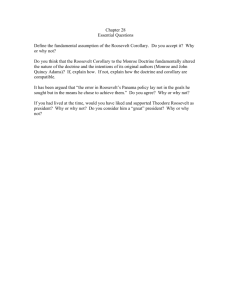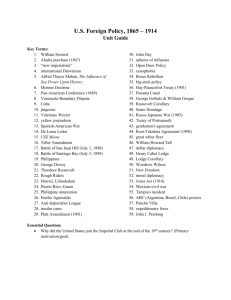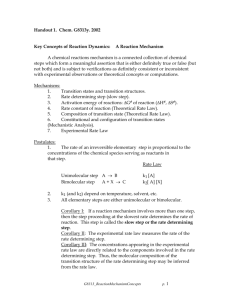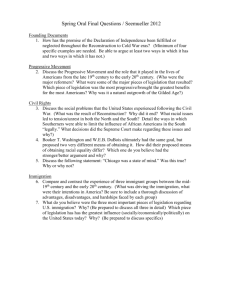A Special Case of the Generalized Girard-Waring Formula Mircea Merca Department of Mathematics
advertisement
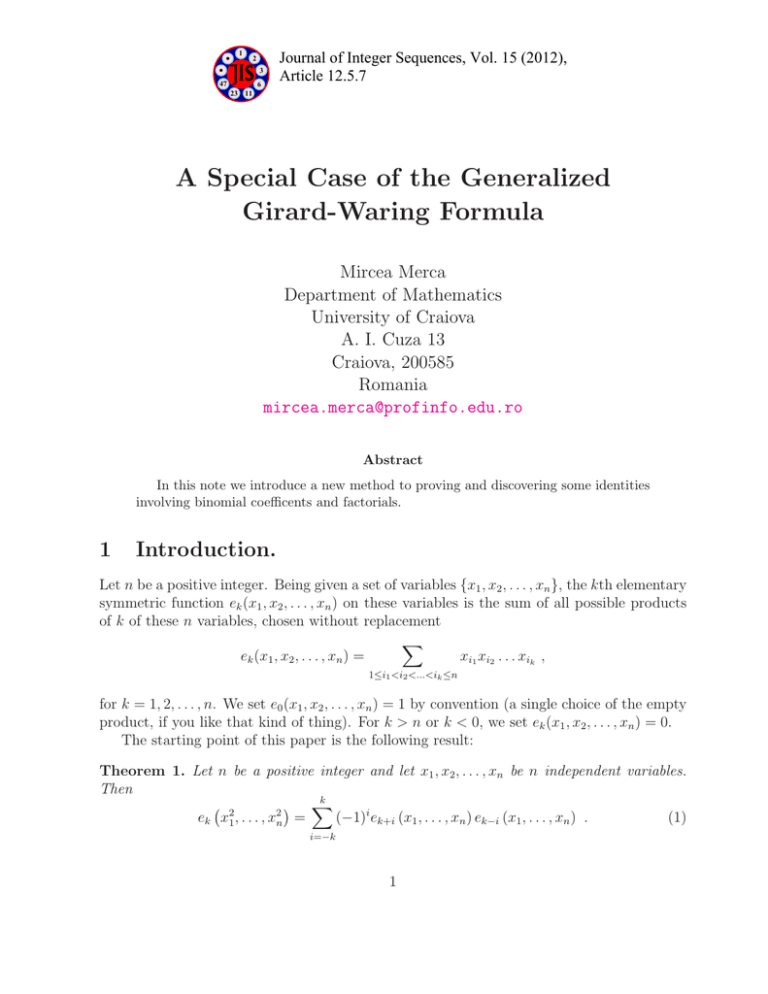
1
2
3
47
6
Journal of Integer Sequences, Vol. 15 (2012),
Article 12.5.7
23 11
A Special Case of the Generalized
Girard-Waring Formula
Mircea Merca
Department of Mathematics
University of Craiova
A. I. Cuza 13
Craiova, 200585
Romania
mircea.merca@profinfo.edu.ro
Abstract
In this note we introduce a new method to proving and discovering some identities
involving binomial coefficents and factorials.
1
Introduction.
Let n be a positive integer. Being given a set of variables {x1 , x2 , . . . , xn }, the kth elementary
symmetric function ek (x1 , x2 , . . . , xn ) on these variables is the sum of all possible products
of k of these n variables, chosen without replacement
X
ek (x1 , x2 , . . . , xn ) =
xi1 xi2 . . . xik ,
1≤i1 <i2 <...<ik ≤n
for k = 1, 2, . . . , n. We set e0 (x1 , x2 , . . . , xn ) = 1 by convention (a single choice of the empty
product, if you like that kind of thing). For k > n or k < 0, we set ek (x1 , x2 , . . . , xn ) = 0.
The starting point of this paper is the following result:
Theorem 1. Let n be a positive integer and let x1 , x2 , . . . , xn be n independent variables.
Then
k
X
ek x21 , . . . , x2n =
(−1)i ek+i (x1 , . . . , xn ) ek−i (x1 , . . . , xn ) .
(1)
i=−k
1
Proof. Taking into account that
n
Y
(x + xi ) =
i=1
and
n
X
en−k (x1 , . . . , xn ) xk
k=0
ek (−x1 , . . . , −xn ) = (−1)k ek (x1 , . . . , xn ) ,
we can write
n
Y
2
x2i
x −
i=1
n
X
=
k=0
n
X
=
k=0
On the other hand, we have
n
Y
i=1
x2 − x2i =
=
=
=
n
Y
!
n
Y
(x − xi )
i=1
n
X
en−k −x21 , . . . , −x2n x2k
(−1)n−k en−k x21 , . . . , x2n x2k .
(2)
!
(x + xi )
i=1
(−1)n−k en−k (x1 , . . . , xn ) xk
k=0
2k
n
X X
!
n
X
en−k (x1 , . . . , xn ) xk
k=0
!
!
(−1)n−i en−i (x1 , . . . , xn ) en−2k+i (x1 , . . . , xn ) x2k .
i=0
k=0
(3)
By (2) and (3), we deduce the relation
n−k
(−1)
en−k
x21 , . . . , x2n
2k
X
=
(−1)n−i en−i (x1 , . . . , xn ) en−2k+i (x1 , . . . , xn ) ,
i=0
that can be rewritten in the following way
2(n−k)
k
(−1) ek
x21 , . . . , x2n
=
=
X
i=0
n−k
X
(−1)n−i en−i (x1 , . . . , xn ) e2k−n+i (x1 , . . . , xn )
(−1)k−i ek−i (x1 , . . . , xn ) ek+i (x1 , . . . , xn ) .
i=k−n
Since ek (x1 , . . . , xn ) = 0 for k < 0 or k > n, we have
n−k
X
(−1)i ek−i (x1 , . . . , xn ) ek+i (x1 , . . . , xn )
i=k−n
=
k
X
(−1)i ek−i (x1 , . . . , xn ) ek+i (x1 , . . . , xn ) .
i=−k
2
(4)
The proof is finished.
It is well-known that the power sum symmetric functions can be expressed in terms
of elementary symmetric functions using Girard-Waring formula [3, eq. 8]. In [4, 5, 8], the
Girard-Waring formula is generalised to monomial symmetric functions with equal exponents.
The relation (1) is the case n = 2 in the generalized Girard-Waring formula [8, Eq. (3)] and
can be used to proving and discovering some identities. To illustrate this we present two
applications involving binomial coefficients and Stirling numbers of the first kind.
2
Identities involving binomial coefficients
Let us consider the binomial coefficients
n
= ek (1, . . . , 1) .
| {z }
k
n
The following identity is a direct consequence of Theorem 1.
Corollary 1. Let k and n be two nonnegative integers. Then
k
X
i
(−1)
i=−k
n
k+i
Taking into account that
n X
n
= 2n
k
k=0
n
k−i
n
.
=
k
n 2
X
n
and
k=0
k
=
2n
n
,
by Corollary 1, we obtain a new identity:
Corollary 2. Let n be a positive integer. Then
X
n
n
2n − 1
n−1
i
=2
−
.
(−1)
k+i k−i
n
0<i≤k<n
This corollary is related in [7] with the sequences A108958. By Theorem 1, we obtain
the following result which is a generalization of Corollary 1.
Corollary 3. Let k and n be two positive integers, and let p be a real number. Then
k
X
i=−k
i
(−1)
(p − 1)(k + i)
1+
n
=
(p − 1)(k − i)
1+
n
(p2 − 1)k
1+
n
3
n
.
k
n
k+i
n
k−i
Proof. Taking into account that
ek (x1 , . . . , xn ) = ek (x1 , . . . , xn−1 ) + xn ek−1 (x1 , . . . , xn−1 ) ,
we can write
n−1
n−1
ek (1, . . . , 1, p) =
+p
| {z }
k
k−1
n−1
k n
n
=
+ (p − 1)
k
n k
(p − 1)k
n
=
1+
.
n
k
According to Theorem 1, the corollary is proved.
The following result is a consequence of Corollary 3.
Corollary 4. Let k and n be two positive integers. Then
k
X
k(n − k) n
n
n
i+1 2
=
.
(−1) i
k+i k−i
k
2
i=1
Proof. Replacing p by 2 in Corollary 3, we obtain
3k
1+
n
k
X
k+i
k−i
n
n
n
i
1+
=
(−1) 1 +
n
n
k
k−i k+i
i=−k
k
X
2k k 2 − i2
n
n
i
=
(−1) 1 +
+
k−i k+i
n
n2
i=−k
2 X
k
k
n
n
i
=
1+
(−1)
k−i k+i
n i=−k
2 X
k
n
n
1
i 2
−
(−1) i
k−i k+i
n i=−k
Now, we use Corollary 1 and, after some simple calculations, we obtain
k
X
i=−k
i+1 2
(−1)
i
n
k−i
n
n
= k(n − k)
.
k+i
k
The corollary is proved.
Remark. To prove Corollary 4 we use Corollary 3 with p = 2. In fact, we could choose for p
any value with the exception of 1. Corollary 4 is related in [7] with the sequence A094305.
4
Taking into account the identities
n
X
n
k
= n2n−1
k
k=0
n
= n(n + 1)2n−2 ,
k
k
k=0
n
X
and
2
by Corollary 4, we get the following identity:
Corollary 5. Let n be a nonnegative integer. Then
X
n
n
i+1 2
(−1) i
= n(n − 1)2n−3 .
k+i k−i
0<i≤k<n
This corollary is related in [7] with the sequence A001788.
At the end of this section we propose the following two exercises:
Exercise 1. Let x1 , x2 , . . . , xn be the zeros of the polynomial
n n−k
x +
(−1) k
x
.
k
k=1
n
X
n
k
Show that
ek
x21 , x22 , . . . , x2n
=n
2
n−1
n
k
+ (−1) 4k
.
k−1
2k
Exercise 2. Let k and n be two positive integers. Prove that
k
X
i=1
3
i 4
(−1) i
n
k+i
n
k−i
k(n − k)(k(n − k) − n) n
=
.
2
k
Central factorial numbers of the first kind
The numbers
s(n + 1, n + 1 − k) = (−1)k ek (1, 2, . . . , n)
(5)
are known as Stirling numbers of the first kind. They are the coefficients in the expansion
(x)n =
n
X
s(n, k)xk ,
k=0
where (x)n is the falling factorial, namely
(x)n =
n−1
Y
k=0
(see [1, p. 278]).
5
(x − k)
Similarly, the central factorial numbers of the first kind are defined in Riordan’s book [6,
p. 213-217] by
n
X
[n]
x =
t(n, k)xk ,
k=0
where
n
x[n] = x x + − 1
.
2
n−1
It is clearly that the t(n, k) are not always integers. For n = 2m, we have
x
[2m]
=
m−1
Y
2
x −k
k=0
2
=
m
X
t(2m, 2k)x2k .
k=0
In [2] the central factorial numbers of the first kind with even indices are denoted by u(n, k) =
t(2n, 2k). Thus, we can see that
u(n + 1, n + 1 − k) = (−1)k ek (12 , 22 , . . . , n2 ) .
(6)
Corollary 6. Let k and n be two positive integers such that k ≤ n. Then
u(n, k) =
k
X
(−1)n−k+i s(n, k + i)s(n, k − i) .
i=−k
Proof. By (1), (5) and (6), we deduce that
u(n, n − k) =
k
X
(−1)k+i s(n, n − k + i)s(n, n − k − i) .
i=−k
According to (4), the corollary is proved.
Corollary 6 is related in [7] to the sequences A008955, A000330, A000596, A000597,
A001819, A001820, A001821 and A204579.
4
Acknowledgement
The author would like to thank Professor Jiang Zeng from Institut Camille Jordan, Université
Lyon 1 for his support. The author expresses his gratitude to Oana Merca for the careful
reading of the manuscript and helpful remarks.
References
[1] Ch. A. Charalambides, Enumerative Combinatorics, Chapman & Hall/CRC Press, 2002.
[2] Y. Gelineau and J. Zeng, Combinatorial interpretations of the Jacobi-Stirling numbers,
Electron. J. Combin. 17 (2010), Paper #R70.
6
[3] H. W. Gould, The Girard-Waring power sum formulas for symmetric functions and
Fibonacci sequences. Fibonacci Quart. 37 (2) (1999) 135–140.
[4] J. Konvalina, A generalization of Waring’s formula, J. Combin. Theory Ser. A 75 (2)
(1996) 281–294.
[5] J. Konvalina, A note on a generalization of Waring’s formula, Adv. in Appl. Math. 20
(1998) 392–393.
[6] J. Riordan, Combinatorial Identities, John Wiley & Sons, New York, 1968.
[7] N. J. A. Sloane, The On-Line Encyclopedia of Integer Sequences, Published electronically at http://oeis.org, 2012.
[8] J. Zeng, On a generalization of Waring’s formula, Adv. in Appl. Math. 19 (1997) 450–
452.
2010 Mathematics Subject Classification: Primary 05E05, 05A19; Secondary 11B65, 11B73.
Keywords: binomial coefficient, central factorial numbers, Stirling number, symmetric function, generalized Girard-Waring formula.
(Concerned with sequences A000330, A000346, A000596, A000597, A001788, A001819, A001820,
A001821, A008955, A094305, A108958, and A135065.)
Received April 26 2012; revised version received May 28 2012. Published in Journal of
Integer Sequences, June 12 2012.
Return to Journal of Integer Sequences home page.
7



